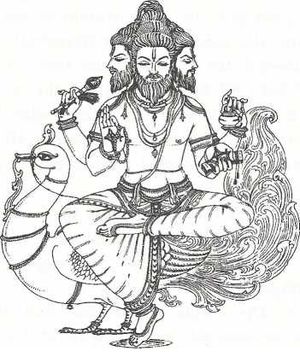Talk:Brahmā
Trinity `Classification[edit]
Popular theologies having its roots in the ancient scriptures mentions the Trinity deities for the existence, sustenance and destruction of the world. The Trinity deities are:
- Brahmā who creates the world
- Viṣṇu who sustains the world
- Śiva who destroys the world
This process of creation (sṛṣti), preservation (sthiti) and destruction (pralaya) continues perpetually in that order. Thus Brahmā is the source or the seed of all that is. His very name indicates, boundless immensity, from which space, time and causation originate, names and forms spring up.
Philosophical Significance of Brahmā[edit]
Philosophically, he is the first stage of manifestation of the notion of individual existence (ahaṅkāra). Theologically, he is the uncreated Creator (Svayambhu), the self-born first Person. He has several designations which are instructive as well as interesting. From the cosmological point of view, he is the Golden Embryo (Hiraṇyagarbha), the ball of fire, from which the universe develops.
Different Names of Brahmā[edit]
Since all created beings are his progeny, he is called as Prajāpati, the Lord of progeny. Some of his names are mentioned below:
- Pitāmaha
- Patriarch
- Vidhi, the ordinator
- Lokeśa, the master of the worlds
- Dhātṛ, the sustainer
- Viśvakarmā, the architect of the world
Shastra describes Brahmā as having sprung from the lotus originating from the navel of Viṣṇu. Hence he is called Nābhija (the navel- born), Kañja (waterborn) and so on. Curiously enough, the name ‘Nārāyaṇa’ (‘the one who dwells in the casual waters’ or ‘the abode of man’) had been applied to him first and later on to Viṣṇu.
Significance of Brahmā[edit]
Brahmā, the creator and Sarasvatī, his consort, are the subjects of several tales in shastra. They can be summarized briefly thus:
- Brahmā was born out of the golden egg produced in the boundless causal waters. His consort Vāc or Sarasvatī was manifested out of him. From their union were born all the creatures of the world.
- Brahmā represents the Vedas and Sarasvati represents their spirit and meaning. Hence all knowledge, sacred and secular, has proceeded from them.
- Once Brahmā became the boar and raised the earth from beneath the waters and created the world. Hence he was also called as Prajāpati.
- The forms of tortoise and fish (later considered as avatāras of Viṣṇu) have been attributed to Brahmā also.
- The great sages Marīci, Atri, Aṅgiras and others are his ‘mind-born’ children. Manu, the Adam of the Aryan race, is his great-grandson.
- Brahmā is easily pleased with austerities and bestows boons on the supplicants, be they gods, demons or human beings.
- Brahmā is the inventor of the theatrical art. Music, dance and stagecraft were revealed by him.
- Brahmā was the chief priest who performed the marriage of Pārvatī with Śiva.
Temples of Brahmā[edit]
In spite of the fact that Brahmā is God the Supreme in the creative aspect and is an equally important member of the Trinity, it is strange that there very few templesa dedicated to him (the most notable of which is at Puṣkar near Ajmer in Rajasthan). Notwithstanding the crude reasons given in some of the purāṇas for the loss of Brahmā’s prestige, it is likely that the Brahmā cult was predominant prior to the growth of the Śiva-Viṣṇu cults.
In the temples dedicated exclusively to Brahmā, his aspect as Viśvakarma (the architect of the universe) is adopted. In this form he is shown as having four heads, four arms holding the rosary, the book, the kuśa grass and the kamaṇḍalu and riding on his swan.
Every temple, be it of Śiva or Viṣṇu, must have a niche in the northern wall for Brahmā, and his icon must receive worship everyday since he is an important parivāradevatā (attendant of the Chief deity).
Image of Brahmā[edit]
The image of Brahmā has four heads facing the four quarters. They represent the four Vedas, the four yugas (epochs of time), and the four varṇas (divisions of society based on nature, nurture and vocation). Usually the faces have beards and the eyes are closed in meditation. There are four arms holding different objects and in different poses. The arms represent the four quarters. The combination and arrangement vary from image to image. The objects usually shown are:
- Akṣamālā - Rosary
- Kurca - A brush of kuśa grass
- Sruk - Ladle
- Sruva - Spoon
- Kamaṇḍalu - Waterpot
- Pustaka - Book
The mudrās or poses of the hand are abhaya (assuring protection) and varada (granting boons). The icon may be either in the standing posture (standing on a lotus) or in the sitting posture (sitting on a haṅisa or swan). Haṅsa or the swan stands for discrimination and wisdom.
Significance of the Objects In the Hands of Brahmā[edit]
The rosary represents time and the waterpot, the causal waters, from which all creation has sprung up. So, Brahmā controls time as well as the principle of causation. The kuśa grass, the ladle and the spoon being sacrificial implements, represent the system of sacrifices which is the means to be adopted by the various creatures to sustain one another. The book stands for knowledge, sacred and secular. He is the giver of all knowledge arts, sciences and wisdom.
Brahmā, The Cheif Priest[edit]
Brahmā is also the name applied to one of the four principal priests in a Vedic sacrifice. He is the most learned of all and is required to know the three Vedas for his professional duties. He acts as a presiding officer of a sacrifice and is silent most of the time. He instructs the adhvaryu priest when his advice is sought for. It is he who prescribes the prāyaścittas (expiatory rites) when mistakes are committed in a sacrifice. In later Vedic literature, he came to be associated with the Atharvaveda.
References[edit]
- The Concise Encyclopedia of Hinduism, Swami Harshananda, Ram Krishna Math, Bangalore


